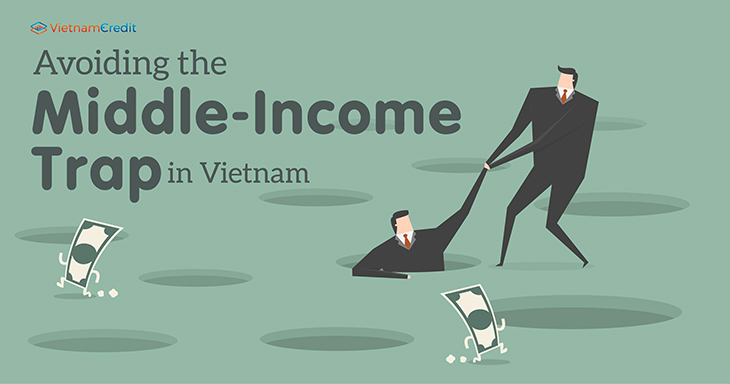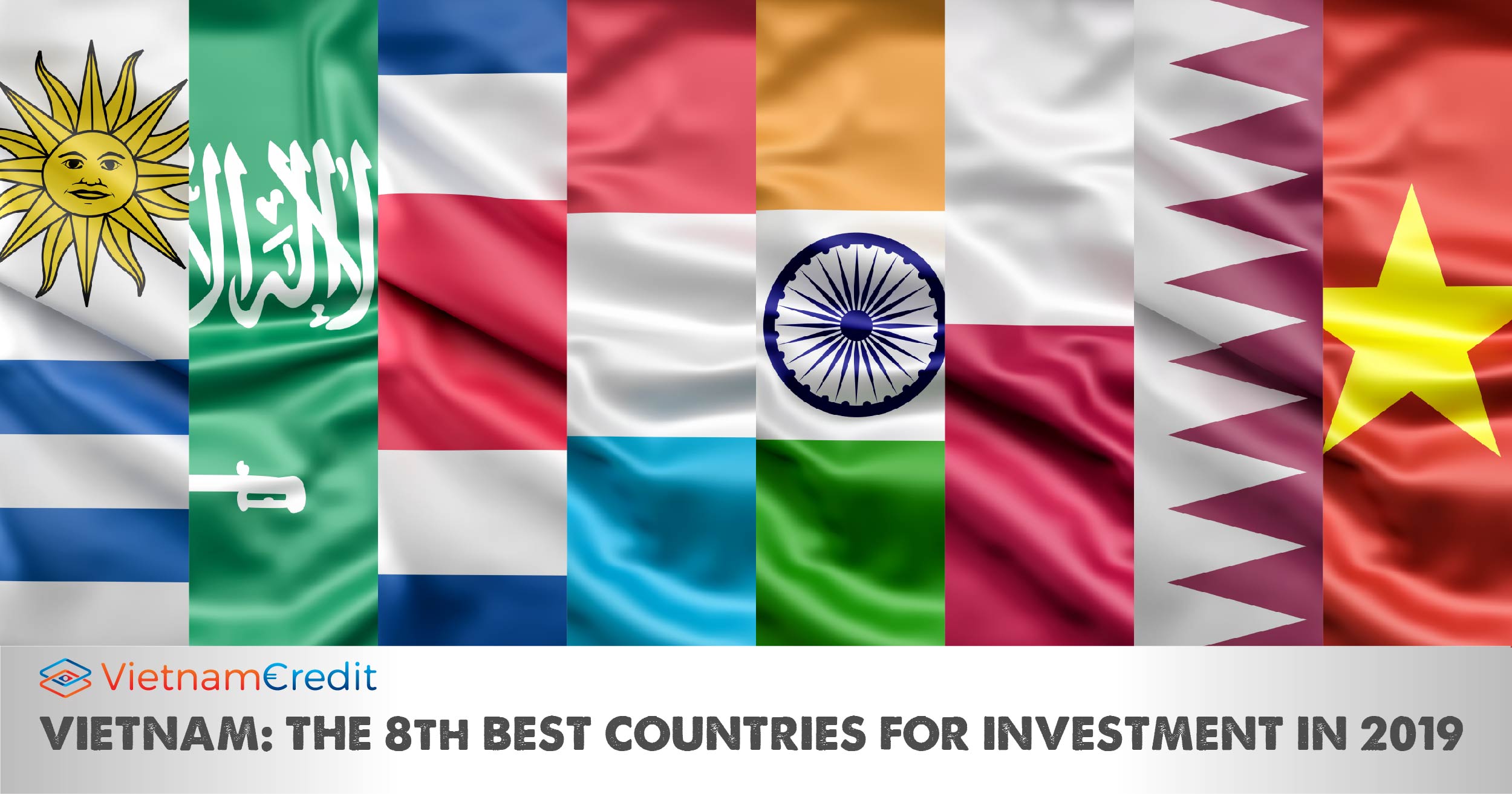In 2007, the term 'middle-income trap' was first mentioned to examine this phenomenon in many Asian countries. So can Vietnam face an economic "trap" in the present or in the future?
I. Middle-income trap in Vietnam?
1. Vietnam as a low - cost country sourcing destination
As one of the most developing countries in Southeast Asia, Vietnam has an abundant labor force, favorable geographical location, and raw materials but there are many challenges for Vietnam in the developing process. In terms of ten years, Vietnam has become increasingly attractive as China, Indonesia, and Thailand to investment from foreign businesses and countries due to low-cost production. Indeed, Vietnam is a low-cost country sourcing destination that a number of businesses and brands located their manufacture, particularly footwear, garments, and furniture industries.
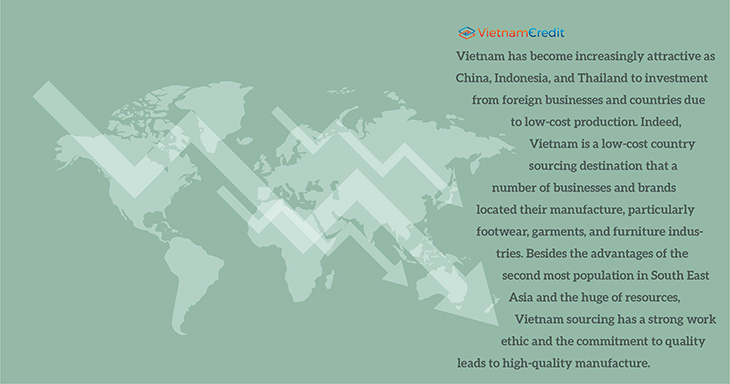
Besides the advantages of the second most population in South East Asia and the huge of resources, Vietnam sourcing has a strong work ethic and the commitment to quality leads to high-quality manufacture. In addition, the workforce in Vietnam is highly literate and willing to be trained in spite of poor education. Hence, it makes labor value not really high and this is also the cost advantage that foreign investors are focusing on. In addition to low labor costs, costs such as import taxes on materials and available materials are low cost but still meet quality requirements. Due to the above advantages and government support, foreign direct investment (FDI) of Vietnam attraction is expected to make a leap in the long-term with more foreign investors including big brands of the world's high-tech manufacturing and services industries. Hence, the strong development of many industries in Vietnam has led to the rising labor cost which may lead Vietnam into a middle-income trap issue in the near future.
2. What is the middle-income trap?
The term middle income trap has formed after the postwar era, where many countries fall into the category of middle-income economies while some reach high-income. However, some countries experience noticeably slow in economic growth and production and face difficulties in getting out of the middle-income economy. One indicator for a middle-income trap country includes the slow growth rates of GDP and the struggle in building and maintaining international competitions.
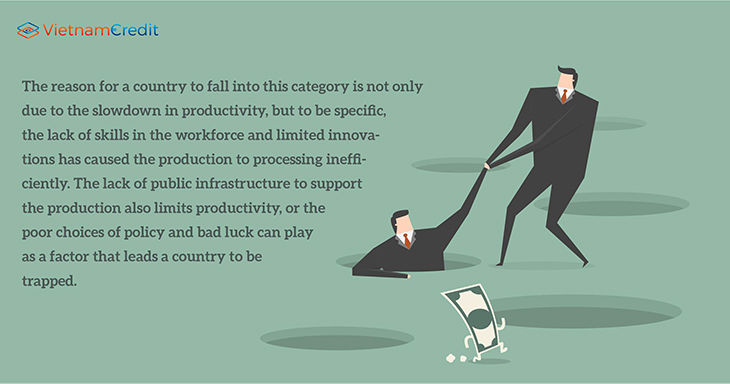
The reason for a country to fall into this category is not only due to the slowdown in productivity, but to be specific, the lack of skills in the workforce and limited innovations has caused the production to processing inefficiently. The lack of public infrastructure to support the production also limits productivity, or the poor choices of policy and bad luck can play as a factor that leads a country to be trapped. The rising wages or labor cost and lack of investment in human capital is the key issues that many middle-income countries faces the high potential of falling in the trap. The middle-income countries account for 75% of the world population, where the GNI per capita for lower-middle-income economies falls between $1,006 to $3,955 and higher middle-income economies from $3,956 to $12,235. Considering the main issues that 53 lower-middle-income countries face consists of its struggle to have basic services like clean water. While the 56 higher middle-income countries fight their way with corruption. However, not all countries that are listed in the middle-income economies fall into the trap. In order for a country to satisfy the definition of the middle-income trap, one has to show its path of development in contrast with the time-invariant. Therefore, the stagnant economic growth and slow growth rate in a long period of time can be a good indicator to categorize if a country falls into the middle-income trap.
3. Is Vietnam currently in a middle-income trap?
Vietnam has come a long way from one of the poorest nations to a middle-income country. Vietnam has become a lower-middle-income country since 2008 as the GDP per capita of the country reached $1,149 and over the past 10 years, the GDP per capita of Vietnam has increased significantly to $2,563 in 2019. In spite of being a middle-income country but Vietnam has not yet fallen into a middle-income trap due to the country’s fast growth rate. Vietnam is among the top 10 fastest-growing economies in the world despite the U.S - China tension which witnesses the slowdown in Chinese demands and affecting SEA countries that depend on export with a high level of exports to China like Malaysia or Singapore. From 2017 to 2019, the GDP growth rate in Vietnam has increased significantly from 6.2% to 7%. And it is predicted that Vietnam might sustain the growth rate at 7% in 2020
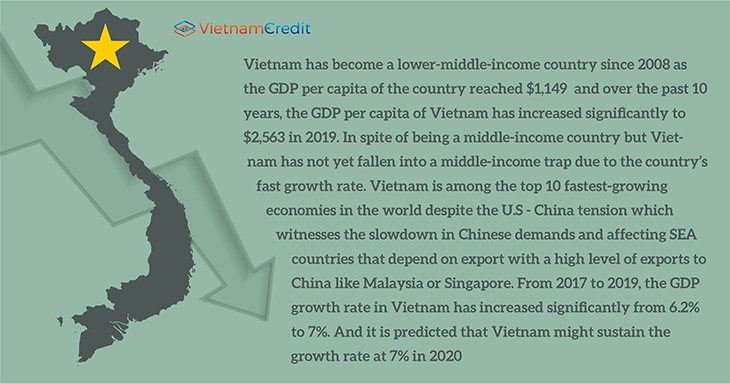
Nonetheless, there are certain factors that could lead Vietnam into a middle-income trap. After the economic reform, Vietnam has been considered as a low-cost country (LCC) sourcing destination by others, an ideal destination for foreign companies to move their production to. Like many other LCCs, the low labor cost and the abundance of unskilled labor are the main factors that are so appealing to foreign investors. However, the appeal of Vietnam’s labor cost has been declining because of the rapid increase in minimum wages while the quality and productivity of the workforce have not been able to compete with many other neighboring nations. The minimum wages in Vietnam have risen 5.3% in 2020 which is lower compared to previous years as the increase was 6.5% in 2019 and 7.3% in 2018. Various major foreign textile companies will slow their expansions and investments in Vietnam and experts worries that the withdrawal of foreign investment will not only restricted in the textile industry if the problem is not being dealt with. Another reason that might cause Vietnam to fall into the middle-income trap is low productivity and a part of the reason is that Vietnam’s population is rapidly aging.
Vietnam is among the five countries with the highest population aging rate in the world, and about 25% of Vietnamese will be elder people by 2050. The golden population of Vietnam is estimated to last from 2010 to 2040 but because of low birth rate and life expectancy is longer which leads to the aging population while the working-age population is shrinking. With an aging population, the young labor force will decrease which leads to lower productivity while the elders spending less than young people and combined with the cost for social welfare and health care for the elders which affects the economic growth rate negatively. In addition, technological applications in Vietnam have been developing but the current capacity and potential are limited and is not yet able to compete with the cost-benefit of human labor. On top of that, the poor infrastructure in Vietnam at the moment might also affect foreign investments, import, and export of many industries, which will in turn impede economic growth.
II. Possible solutions
1. Training, attracting, retaining, and allocating skilled labor
Skilled labor can be identified as workers with special skills or knowledge of a specific industry. They also have a higher expertise level through education, training, and experiences. Right now, skilled labor only accounts for 12 % of the total workforce in Vietnam.
In an organization, training skilled labor can not only increase company productivity but also a way to reduce employees’ turnover. In addition, training employees is a way to enlarge the engagement, and it also supports the company to have a better risk management system. In 2019, the Vietnamese government was trying to develop a new strategy for training employees by reforming the education and training systems but it is not yet available for 2020.
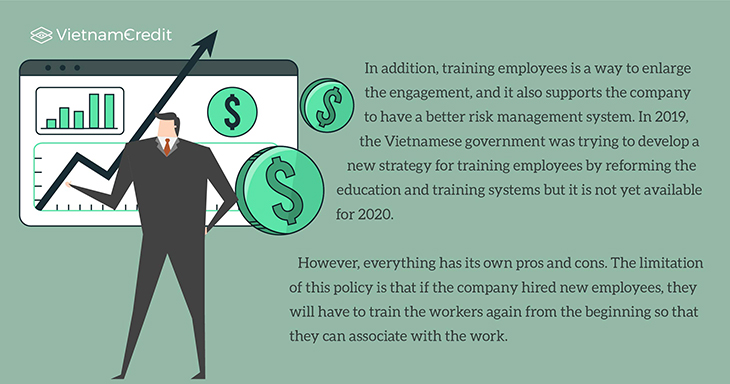
However, everything has its own pros and cons. The limitation of this policy is that if the company hired new employees, they will have to train the workers again from the beginning so that they can associate with the work. However, if the company tries to train the existing employees, they may leave the organization due to the development of skill and knowledge. Plus, Vietnam is the lack of proper education and training mechanisms to push the workforce to lead the economy towards competitiveness and efficiency. The small size of the skilled workforce and the inefficient use of the nation's most important resources have broken down the productivity and the economy's competitiveness.
Foreign labor means people who work in a different country on a temporary basis. Foreign workers are employed by companies, recruiting agencies, or" hired while they are searching for domestic employment to support the country's workforce for a limited time or provide skills based on the contract the country seeks".
One of the advantages when recruiting a foreign workforce is your company can have a variety of skills and cultural. This is not only an opportunity for the company to have better knowledge and human resources but also a way to integrate with the international. Moreover, workers in foreign countries are often carefully trained and educated more than workers in Vietnam. This can save the company time for training workers and they can assist the company in teaching others. In addition, when these employees go abroad to work, they often have hard work as well as the consent to complete any assigned work. This can help the company to manage better as well as increase productivity and efficiency.
However, the first disadvantage of that tactic is that these workers can only work for a short time in your company. This is because they are working in a country where they are not citizens, so their visas are only valid for a certain period of time. Moreover, although the price of foreign workers is quite cheap, it is still a high price compared to the Vietnam market. Moreover, when we hire foreign workers, it can lead to miscommunication because of differences in language and working habits.
So why do we have to retain talent? First of all, talented employees are skilled workers that match the needs of the organization and meet any labor requirements. That means they are top employees in the company and can give the company many benefits to grow in the long run. Plus, every company spends a lot of money, time, and resources to train the perfect employee. If the company is unable to retain that employee, it is a pretty big loss in its human capital investment (Retaining talents n.d).
In terms of the limitation of this policy, employees will not be loyal to the company, they can leave the company to seek a better opportunity or go out and open their own company. Besides, if the company retains too many talents, it can create a competitive barrier that makes it harder for the company to manage human resources. Moreover, because the talents they have all the skills and ability to adapt to the job, so the division of work in the company can not be fair which may make many people lose their position in the company.
2. Focus on developing infrastructure
In the process of economic growth and poverty reduction, infrastructure has always been considered one of the important factors. Power sources & power generation sources (coal, oil), road & rail transport systems, ports, airports, and telecommunications are important components of the infrastructure. The system of synchronous and modern development infrastructure will promote economic growth, improve the productivity and efficiency of the economy, and contribute to solving social problems. In contrast, an underdeveloped infrastructure system is a major impediment to development. In many developing countries currently, inadequate and weak infrastructure has caused a stagnation in the flow of resources, difficulty in absorbing and investing capital, which has been causing direct effects on economic growth. The current policy of the Vietnamese government at the moment regarding this matter is to invest in the development of infrastructures. Although a series of large-scale transport works, main roads, big bridges in cities have been upgraded and newly built to serve economic development - social and international integration, further action should be taken to be able to aid the fast-growing economy of Vietnam.
Since the development of infrastructure could aid the overall economy and public welfare of the entire nation, this should be one of the government priorities at all times. Vietnam has great potential and favorable geographical location to take advantage of investment capital and further improve the infrastructure system. However, the management method of the expressway system is not really effective in order to maximize utilization and reduce traffic congestion on the roads. Therefore, the Government needs to strengthen supervision to ensure efficient allocation of resources as well as the safety and sustainability of the facilities. In the long term, the Government should consider the application of new technologies for transport infrastructure such as Blockchain, e-Do (electronic delivery orders) for retail shipments, electronic ports, electronic charges, etc. Along with that, the process of synchronizing and integrating procedures into the national single-window mechanism, the ASEAN single-window mechanism of the ministries and branches should soon be completed to address the goal of perfecting and synchronizing the whole infrastructure system because this is the driving force for the development process as well as attracting investment.
Another method to promote the development of infrastructure is to attract investment from domestic and foreign economic sectors. Implementation of diversification mode of investment, especially to promote investment in the form of Public-Private Partner (PPP). In the context, in the next 20 years, Vietnam needs to attract 15-20 billion USD of private investment in developing national infrastructure every year, then the PPP model is considered an of the solutions to help Vietnam fill the investment capital flow before the development demand of this field and reduce the burden on the State. PPP is a project implementation method in which private enterprises benefit from the investment, construction, maintenance, and operation of public infrastructure, while the Government reduces taxes and supports a financial part. As of July 2019, Vietnam has a total of nearly 340 projects invested in the form of PPP, including 220 transport projects, 18 energy industry projects. Along with other projects in the field, it has attracted nearly 70 large and small investors from countries such as Korea, China, or France. However, it is worth mentioning that, according to many investors, the most important issue of the PPP Law is the project support mechanism, the sharing of investment risks between the state and the private sector so completing the framework PPP legislation is the first important solution to promote foreign investment attraction in the form of PPP.
3. Encouraging the development and integration of AI and automation into production
The above options can be implemented on their own with the hope that in the future, the investment in talent and infrastructure can help create innovations in the national economy and turn Vietnam into a country. development. Without a clear development goal, however, it is highly likely that this investment will go to waste with no significant positive effects on the economy. For this last recommendation, we recommend combining the two as part of the AI technology development and integration process and manufacturing automation.
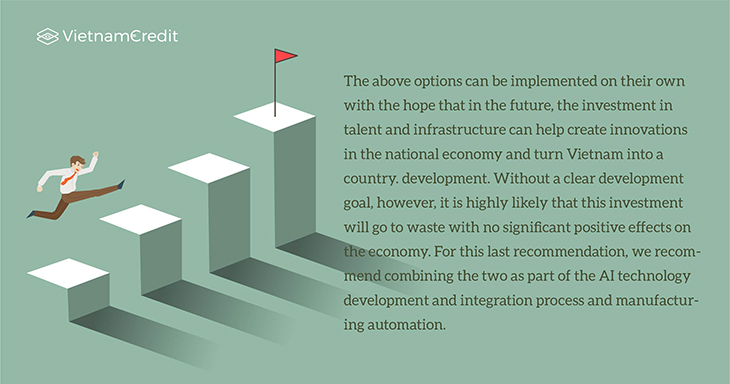
a. Why invest in AI and automation?
The most concerning issue with the first option of having more skilled labor within the country is labor allocation. This third option could offer a chance to alleviate this issue at least partially.
Training and attracting more skilled laborers is one of the ways to directly affect the average income of the nation, this had been discussed above. However, without suitable jobs that require their skills, their training would be for naught and they will be forced to take up unskilled labor positions, move abroad, or stay unemployed. Developing and integrating AI and automation in production requires a lot of specialized training thus would provide some opportunities for a specific group of skilled labor who are AI and automation engineers.
Should the government employ the policies to encourage training skilled labor, more would choose to become skilled labor, which would pose a problem. The majority if not all of the FDI into Vietnam were invested by companies seeking low-cost unskilled laborers for labor-intensive jobs, having more skilled labor that demand more wages would seem attractive to them. Since FDI is a major contributor to the nominal GDP of Vietnam, 6.3% of nominal GDP in 2019, making the country less attractive for foreign investors could impact the economy negatively. Nonetheless, the government’s policies of encouraging the development and integration of AI and automation in manufacturing within the country, offering many foreign manufacturing firms a chance to replace unskilled human labor with a more productive factor of production.
➢ Reducing the reliance on the labor market on labor cost
As mentioned in the above section, the development and integration of AI and automation will help companies to find an alternative eventually the way to produce once they transition out of hiring unskilled labor. The rise of labor costs in Vietnam is inevitable for the growth of the nation and will have to happen eventually. To be able to move on forward, replacing labor with more productive technology is required and will provide more room for the average labor cost of the nation to increase without upsetting investors.
➢ Developing a supporting industry
With the encouragement of AI and automation, this could become a leading industry that drives the growth of the nation, reducing the reliance of economic growth on FDI if it is allowed to grow and mature enough to compete with technology from other foreign markets.
Another benefit of developing AI programming and automation engineering as a new industry is it can support most if not all other manufacturing industries. If this industry is brought up successfully, it could become a new competitive advantage of the manufacturing industries within the nation, prompting the development of existing ones like vehicle manufacturing as well as the emergence of others not yet available in Vietnam.
b. Development and integration strategy
-
Resource investment: It is no doubt that bringing up an industry and ensuring its growth requires significant resource investment, most notably, money and time investment. Policies that encourage the training as well as attracting skilled labor as mentioned and the development of the economic infrastructure to aid the growth of AI and automation integration above need to be funded by the government. In addition, for the AI and automation technology of Vietnam to develop catch up to the current level of technology from other nations, other trade policies will have to be carried out, which will also require monetary investments. Even with suitable policies and investment,
● Competency of the government:
-
Encouraging people to study in the field of I.T and technology.
-
Attracting and retaining skilled labor and advisor from countries with developed AI and automation technology by providing them with suitable job positions, government support in regard to accommodation and residency.
-
Increase government spending on and attract, acquire foreign funding for developing infrastructures to aid economic growth
● Attracting foreign manufacturing firms and encourage domestic manufacturing firms to open up additional opportunities for AI programming and automation engineering to develop domestically
At the moment, AI and automation technology imported by manufacturing firms are considered factors of production, thus, as part of Vietnam’s policies to increase the openness of the market and the aim to increase domestic production, the current import tax rate for this type of production goods has a very low rate. This is one of the competitive advantages that attract FDI since will have to pay less tax when they want to set up a facility within the country.
However, many argued that the downside of having open trade for a product of a not yet developed industry is that it would allow more competitors to enter the market and this competitive pressure will crush the domestic industry before it has enough time to grow. Basically, the development of any industry is left to chance.
The most common argument for trade protectionism is known as the ‘infant industry argument’, in which import taxes, tariffs, and quotas are justified as for the protection of a young industry against foreign competitive pressure. On the other hand, the argument against it is that it creates deadweight loss, economic loss that benefits no one and could be the cause of many economic depressions.
A direct example of an industry that failed due to trade protectionism could be found in Brazil in the late 1900s. The nation tried to nurture its computer manufacturing industry by imposing a high import tax rate of 30% on foreign products. However, it failed, the industry failed to compete against foreign products in both prices and quality.
Nonetheless, imposing import taxes, tariffs and quotas are not the only protectionist policies, subsidy (government incentive) could also be used as a protectionist policy. In the case of the development and implementation of AI programming and automation engineering industry, wage and production subsidy could be employed to promote its growth without affecting foreign competitors in the short run.
Firstly, wage subsidy programs will allow more skilled laborers to have a desirable job, in this case, the implementation of such programs will allow manufacturing firms within the country to afford skilled laborers in the field of I.T and technology for R&D of AI and automation integration. Such programs will also encourage the emergence of new AI programming and automation engineering firms.
Secondly, production subsidy policies aiming toward AI programming and automation engineering firms to encourage them to start producing and increasing product output and slowly compete with foreign suppliers.
Even though in the short run, the above subsidy programs have little to no effect on the presence of foreign competitors in the domestic market, thus, domestic firms will have to continuously innovate and adapt, there is still a chance it might fail since it growth might be purely or partially based on government aid. To minimize the chance of this outcome, the industry’s progress has to be strictly monitored by the government to control the amount of aid provided. This would require experts in the field to be available for consorting, constant feedback from individual manufacturing firms, and, ideally, product information from the competitors.
Another concern with a subsidy is that it might give rise to corruption and only certain firms will receipt government aid. Fortunately, over the last few years, policies and measures had been carried out to reduce corruption within the government departments itself.
The final concern with this final option is that it will surely cost a lot of money for an undetermined amount of time, basically, it is the combination of both previous options and more. On top of that, it requires a lot of effort and there is little room for mistakes as policies suggested in this final option might not only affect the development and integration of technology within the manufacturing industry, it might also cause employment-related issues arising from imbalance labor training, reducing FDI leading to affected growth rate from the fast-growing labor cost and affecting trade relations with other countries because of the protectionist policies.
An Nguyen - Vietnam Credit

